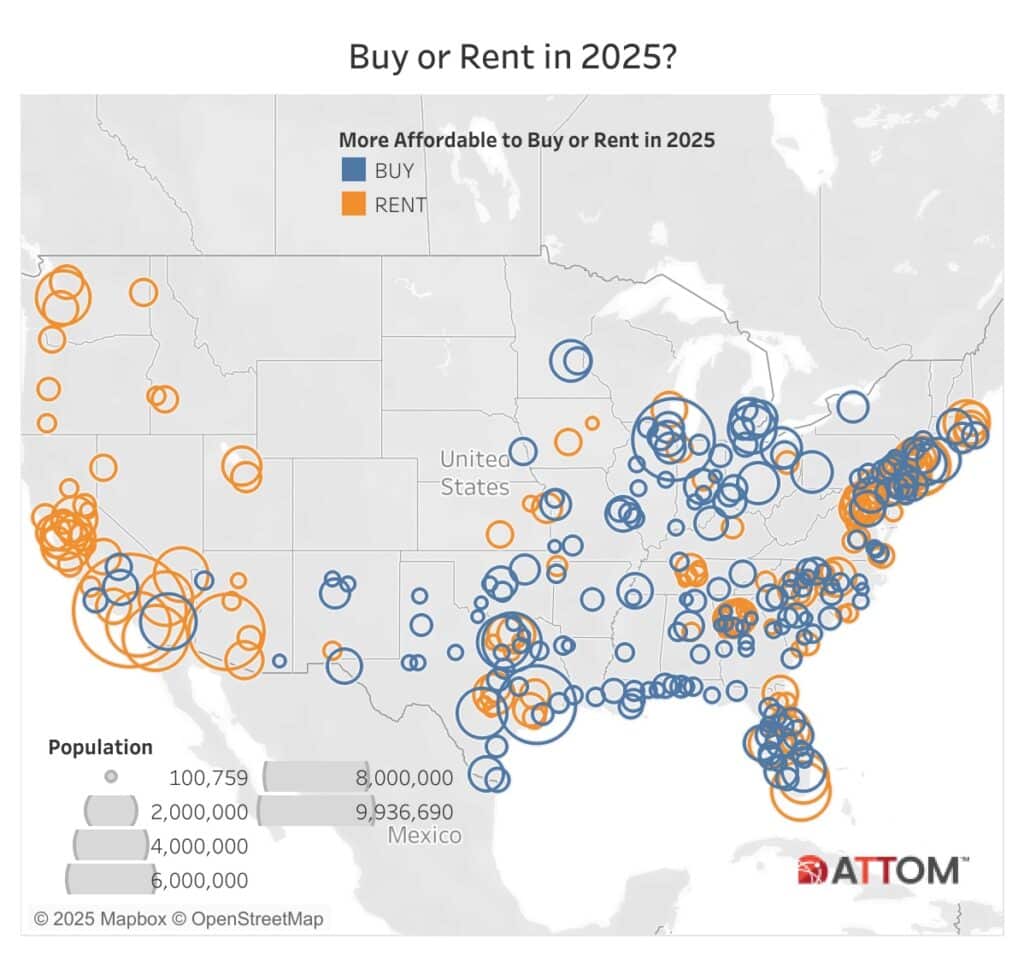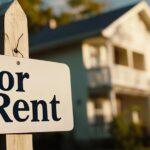According to the 2025 Rental Affordability Report published by ATTOM, in over half of county-level markets nationwide, owning a home is more cost-effective than renting a three-bedroom apartment. The survey showed that the ordinary American worker still finds it tough to own or rent, typically spending between 25 and 60 percent of their income.
However, in nearly 60% of the 341 county-level markets with sufficient data to evaluate, the principal homeownership costs of ordinary single-family homes still require a lesser percentage of average wages than renting three-bedroom homes.
“Buying or renting a home in the U.S. these days can be like searching for a diamond in a pile of marbles, and it’s only getting worse in most markets as the cost of both goes up,” said Rob Barber, CEO at ATTOM. “However, in most parts of the country, homeownership is somewhat more attainable for those who can gather the necessary resources to cover down payments that often surpass $200,000.”
Even while median home prices have generally increased more quickly over the past year than average rentals nationwide, owning is still the more cost-effective option—for those who can afford a down payment.
This report’s study included median home prices from public-record sales deeds in counties with enough single-family home sales data, as well as average rent data gathered by ATTOM. The Bureau of Labor Statistics‘ average wage data was blended with information from those two sources.

Geographical Differences Impacting U.S. Homeownership
In 225, or 66%, of the 341 counties examined in the study, median prices for single-family homes have either risen more or decreased less than average three-bedroom rents over the past 12 months. Counties with a population of 100,000 or more, enough single-family house sales in 2025, and enough information demonstrating increases in three-bedroom rents between 2024 and 2025 were included in the analysis.
The most populous counties where median home prices have risen faster or declined less than average three-bedroom rent over the past year are:
- Los Angeles County, CA
- Cook County (Chicago), IL
- Maricopa County (Phoenix), AZ
- San Diego County, CA
- Orange County, CA
The Lone Star state is on a roll! The largest among the 116 counties in the report (34%) where changes in average three-bedroom rents have outpaced shifts in median prices are:
- Harris County (Houston), Texas
- Tarrant County (Fort Worth), Texas
- Bexar County (San Antonio), Texas
- Suffolk County, NY (outside New York City)
- Franklin County (Columbus), Ohio

Significant differences in the affordability of owning versus renting exist among various regions of the country, with buying a residence most favorable in the Midwest and South, followed by the Northeast.
About 60% of counties in the South and 80% of counties in the Midwest require a smaller percentage of typical wages to be owned. About half of the Northeast share this trait. The one area that defies the trend, however, is the West. Renting is the most cost-effective option in the region of the United States. In over 80% of western markets, renting is the superior choice.
Among the 341 counties reviewed, the biggest affordability gaps in favor of home ownership are in:
- Suffolk County, NY (outside New York City) (major home-ownership expenses on typical homes purchased in 2024 consume 59% of average local wages while average three-bedroom rents require 159%)
- Atlantic County (Atlantic City) NJ (48% for owning vs. 111% or renting)
- Collier County (Naples) FL (79% vs. 127%)
- Indian River County (Vero Beach), FL (47% vs. 83%)
- Charlotte County (Punta Gorda), FL (43% vs. 69%)
The largest disparities for renting are found in:
- Alameda County (Oakland), CA (average three-bedroom rents require 48% of average local wages while major home-ownership expenses on typical homes purchased in 2024 require 87%)
- Honolulu County, Hawaii (64% for renting vs. 103% for owning)
- San Mateo County, CA (31% vs. 69%)
- San Clara County (San Jose), CA (27% vs. 64%)
- Loudoun County, VA (outside Washington, DC) (45% vs. 81%)

Midwestern Counties Boast More Affordable Homes Amid Price Increases
Although ownership strains household finances, it is still far more inexpensive in the Midwest. In 231 of the 341 counties examined for the survey, significant property ownership expenses account for more than one-third of the average local wage (68%), according to the report. However, there are also significant regional variations in that pattern. That only applies to roughly 25% of midwestern counties, which have some of the lowest housing prices in the country. In other areas, between 66 and 98% of county-level markets require more than one-third of average earnings.
Assuming a 20% down payment on a property purchase, the most economical local markets for homeownership are:
- Jefferson County (Birmingham), AL (15% of average local wages needed for major ownership expenses on homes bought last year)
- Wayne County (Detroit), MI (15%)
- Peoria County, IL (15%)
- Montgomery County, AL (16%)
- Mobile County, AL (17%)
The least affordable counties for owning are led by:
- Orange County, CA (outside Los Angeles) (110%of average local wages needed to own)
- Kings County (Brooklyn), NY (106%)
- Honolulu County, FL (103%)
- San Luis Obispo County, CA (100%)
- Monterey County, CA (99%)

In 260 of the 341 counties examined for the survey, average three-bedroom leases cost more than one-third of average local wages (76%), according to the report. However, the bulk of markets in the Midwest are below the one-third criterion, indicating that the Midwest once again has the highest share of more affordable places.
The most affordable markets for renting are:
- Black Hawk County (Waterloo), IA (20% of average local wages needed for average three-bedroom rents)
- Wayne County (Detroit), MI (22%)
- Genesee County (Flint), MI (23%)
- Jefferson County (Birmingham), AL (23%)
- Hinds County (Jackson), MS (23%)
The least affordable markets for renting among those analyzed are:
- Suffolk County, NY (outside New York City) (159% of average local wages needed to rent)
- Collier County (Naples), FL (127%)
- Atlantic County (Atlantic City), NJ (111%)
- Santa Barbara County, CA (107%)
- Riverside County, CA (91%)
Consumer Wages Rising Faster Than Asking Rents
In over three-quarters of local markets, wages are increasing more quickly than rents. This is a good thing, right? Average wages are increasing more or declining less than average three-bedroom rents in 245 of the 341 counties analyzed in the report (72%).
The markets experiencing the fastest wage growth include:
- Los Angeles County, CA
- Cook County (Chicago), IL
- Harris County (Houston), Texas
- Maricopa County (Phoenix), AZ
- San Diego County, CA

Average rents are growing faster than average wages in 96 of the counties in the report (28%), including:
- Suffolk County, NY (outside New York City)
- Franklin County (Columbus), Ohio
- Oakland County, MI (outside Detroit)
- Hennepin County (Minneapolis), MN
- Cuyahoga County (Cleveland), Ohio
In half of the country, home prices are rising faster than wages. In 177 of the 341 counties in the survey, median home prices are increasing or decreasing more than average wages (52%).
They markets where home price increases are outpacing wage growth include:
- Los Angeles County, CA
- Cook County (Chicago), IL
- San Diego County, CA
- Orange County, CA (outside Los Angeles)
- Miami-Dade County, FL
“The current situation is tenuous,” Barber said, “especially if mortgage rates continue to rise as they have in the last few months. But for now, homeownership is the more viable choice.”
Overall, owning a home is less expensive than renting in the US, but both still place a heavy burden on people all around the country. However, despite all the financial hurdles first-time buyers, sellers, or seasoned homeowners may face, the American Dream is still alive, well, and attainable.
To read the full report, including more data, charts, and methodology, click here.






